Taxation Law Assignment: T1 2018, Taxation Law Course, University
VerifiedAdded on 2023/06/10
|11
|2723
|476
Homework Assignment
AI Summary
This taxation law assignment addresses several key concepts within Australian taxation. It begins by defining "Permanent Establishment" in the context of the UK/Australia Double Tax Agreement, explaining how business profits of UK-incorporated enterprises are taxed in Australia and the implications of contracts made through independent agents. The assignment then examines the tax residency of an individual, Andrew McSwington, and his tax liabilities related to income earned from playing baseball in Australia, considering sign-on fees, salary, and rental income from a property purchased in Australia. The assignment further explores the tax treatment of profits and gains in business, referencing the Myer Emporium Ltd v FCT case and other relevant precedents. It also delves into deductible expenses, differentiating between preliminary and ongoing costs, and analyzing the incidental and relevant test for allowable deductions, with examples like interest on loans. Finally, the assignment discusses Australian tax reform, specifically the 50% Capital Gains Tax (CGT) discount, its effectiveness, and its impact on investment incentives and tax revenues.
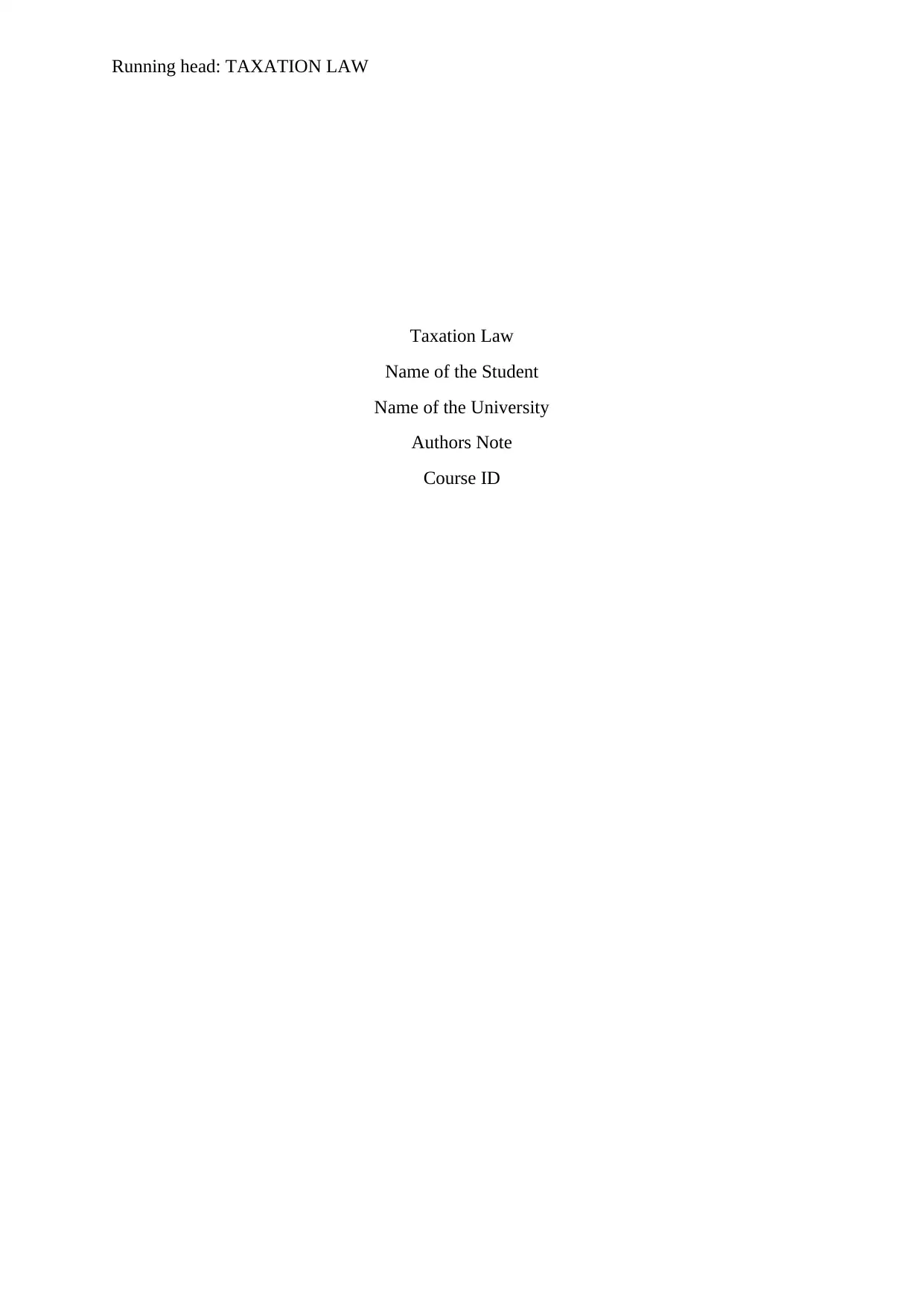
Running head: TAXATION LAW
Taxation Law
Name of the Student
Name of the University
Authors Note
Course ID
Taxation Law
Name of the Student
Name of the University
Authors Note
Course ID
Paraphrase This Document
Need a fresh take? Get an instant paraphrase of this document with our AI Paraphraser
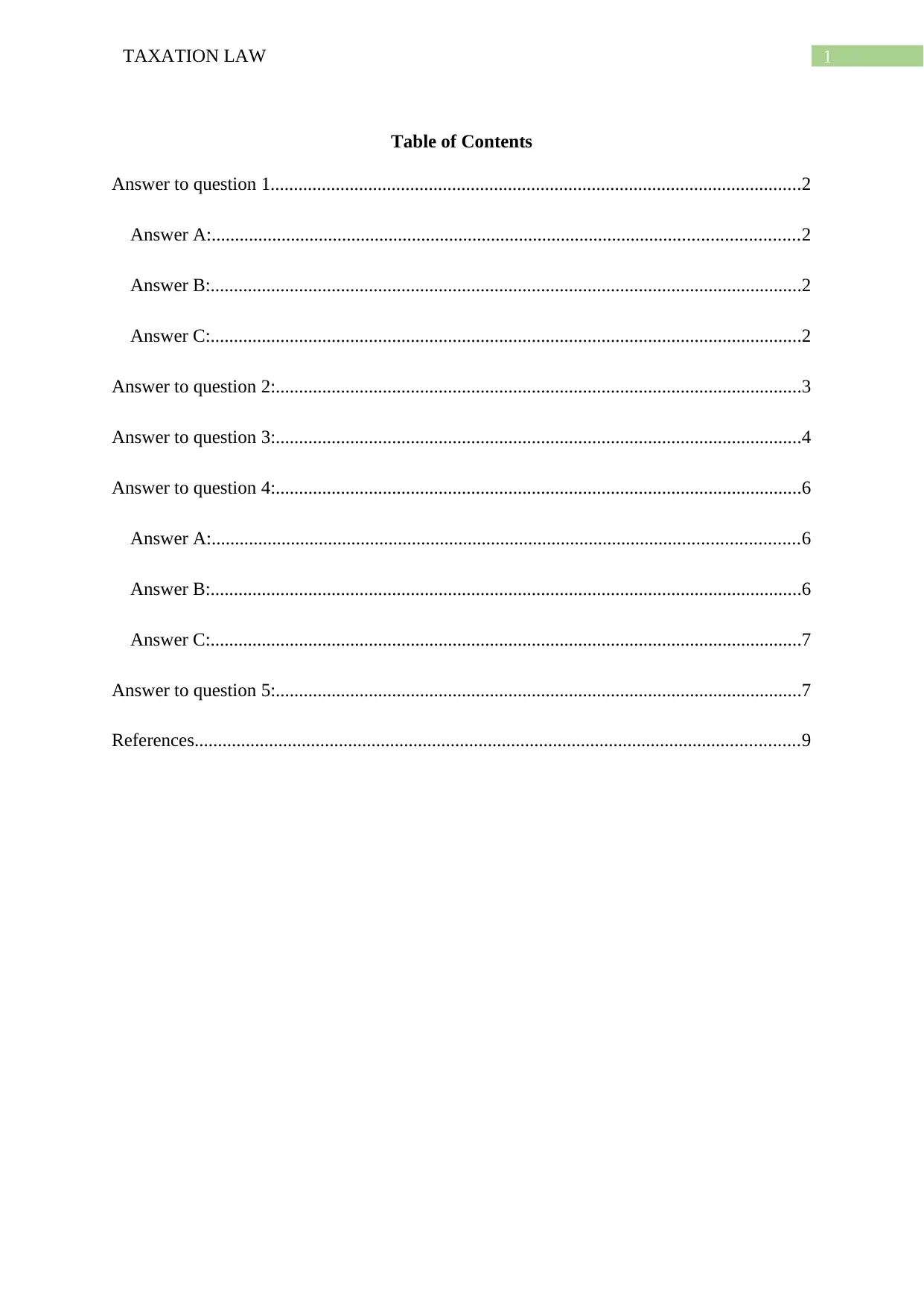
1TAXATION LAW
Table of Contents
Answer to question 1..................................................................................................................2
Answer A:..............................................................................................................................2
Answer B:...............................................................................................................................2
Answer C:...............................................................................................................................2
Answer to question 2:.................................................................................................................3
Answer to question 3:.................................................................................................................4
Answer to question 4:.................................................................................................................6
Answer A:..............................................................................................................................6
Answer B:...............................................................................................................................6
Answer C:...............................................................................................................................7
Answer to question 5:.................................................................................................................7
References..................................................................................................................................9
Table of Contents
Answer to question 1..................................................................................................................2
Answer A:..............................................................................................................................2
Answer B:...............................................................................................................................2
Answer C:...............................................................................................................................2
Answer to question 2:.................................................................................................................3
Answer to question 3:.................................................................................................................4
Answer to question 4:.................................................................................................................6
Answer A:..............................................................................................................................6
Answer B:...............................................................................................................................6
Answer C:...............................................................................................................................7
Answer to question 5:.................................................................................................................7
References..................................................................................................................................9
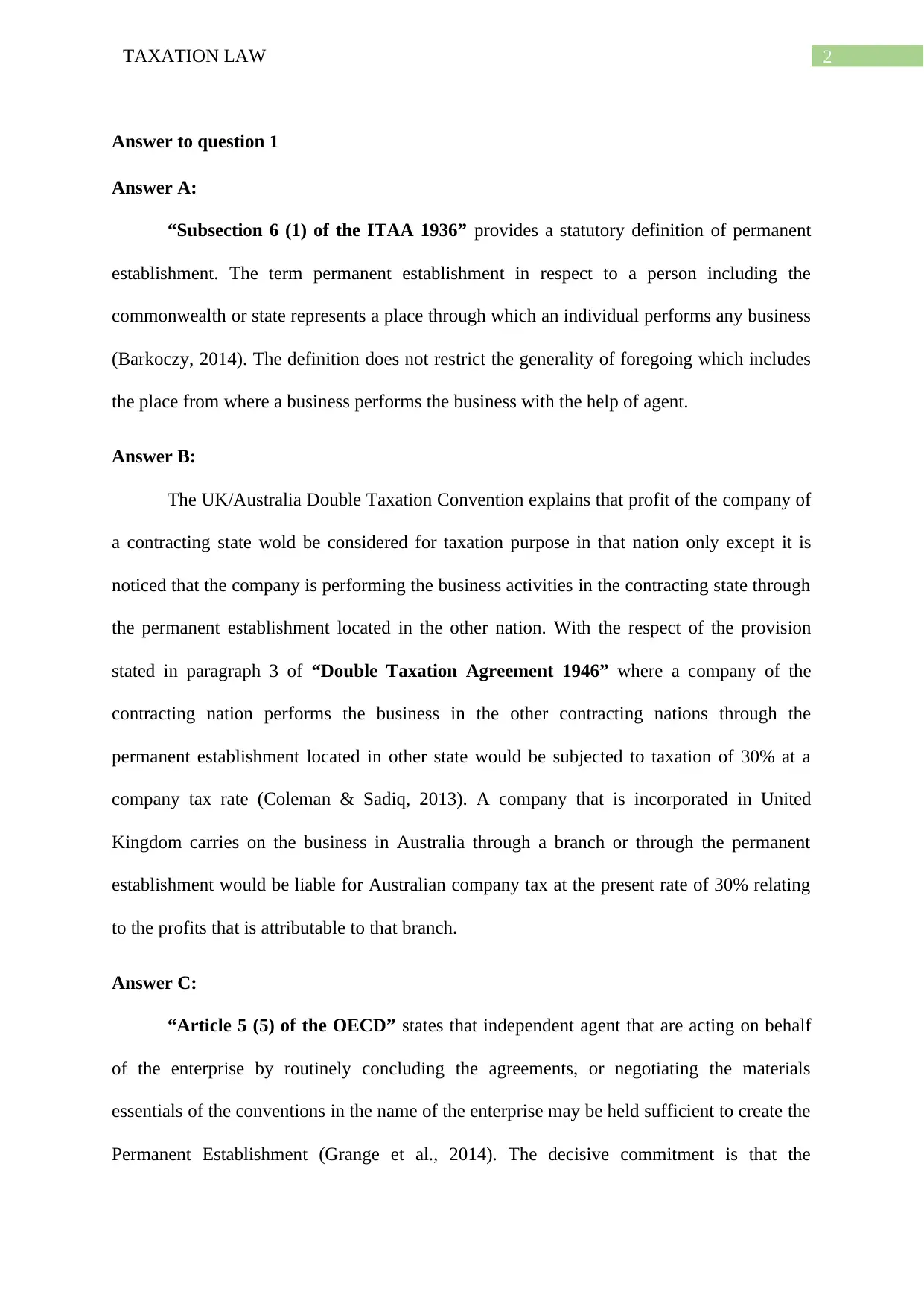
2TAXATION LAW
Answer to question 1
Answer A:
“Subsection 6 (1) of the ITAA 1936” provides a statutory definition of permanent
establishment. The term permanent establishment in respect to a person including the
commonwealth or state represents a place through which an individual performs any business
(Barkoczy, 2014). The definition does not restrict the generality of foregoing which includes
the place from where a business performs the business with the help of agent.
Answer B:
The UK/Australia Double Taxation Convention explains that profit of the company of
a contracting state wold be considered for taxation purpose in that nation only except it is
noticed that the company is performing the business activities in the contracting state through
the permanent establishment located in the other nation. With the respect of the provision
stated in paragraph 3 of “Double Taxation Agreement 1946” where a company of the
contracting nation performs the business in the other contracting nations through the
permanent establishment located in other state would be subjected to taxation of 30% at a
company tax rate (Coleman & Sadiq, 2013). A company that is incorporated in United
Kingdom carries on the business in Australia through a branch or through the permanent
establishment would be liable for Australian company tax at the present rate of 30% relating
to the profits that is attributable to that branch.
Answer C:
“Article 5 (5) of the OECD” states that independent agent that are acting on behalf
of the enterprise by routinely concluding the agreements, or negotiating the materials
essentials of the conventions in the name of the enterprise may be held sufficient to create the
Permanent Establishment (Grange et al., 2014). The decisive commitment is that the
Answer to question 1
Answer A:
“Subsection 6 (1) of the ITAA 1936” provides a statutory definition of permanent
establishment. The term permanent establishment in respect to a person including the
commonwealth or state represents a place through which an individual performs any business
(Barkoczy, 2014). The definition does not restrict the generality of foregoing which includes
the place from where a business performs the business with the help of agent.
Answer B:
The UK/Australia Double Taxation Convention explains that profit of the company of
a contracting state wold be considered for taxation purpose in that nation only except it is
noticed that the company is performing the business activities in the contracting state through
the permanent establishment located in the other nation. With the respect of the provision
stated in paragraph 3 of “Double Taxation Agreement 1946” where a company of the
contracting nation performs the business in the other contracting nations through the
permanent establishment located in other state would be subjected to taxation of 30% at a
company tax rate (Coleman & Sadiq, 2013). A company that is incorporated in United
Kingdom carries on the business in Australia through a branch or through the permanent
establishment would be liable for Australian company tax at the present rate of 30% relating
to the profits that is attributable to that branch.
Answer C:
“Article 5 (5) of the OECD” states that independent agent that are acting on behalf
of the enterprise by routinely concluding the agreements, or negotiating the materials
essentials of the conventions in the name of the enterprise may be held sufficient to create the
Permanent Establishment (Grange et al., 2014). The decisive commitment is that the
⊘ This is a preview!⊘
Do you want full access?
Subscribe today to unlock all pages.

Trusted by 1+ million students worldwide
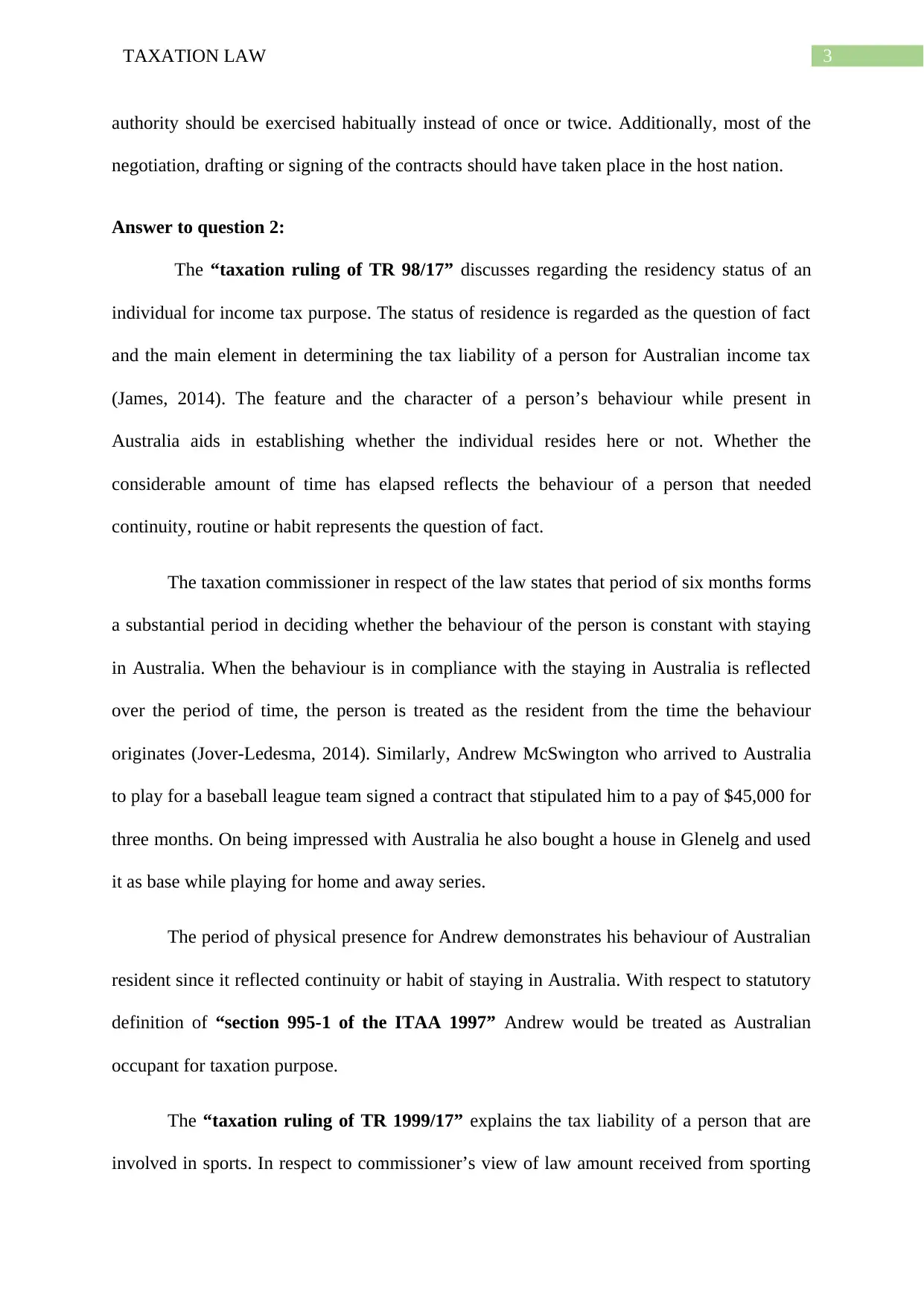
3TAXATION LAW
authority should be exercised habitually instead of once or twice. Additionally, most of the
negotiation, drafting or signing of the contracts should have taken place in the host nation.
Answer to question 2:
The “taxation ruling of TR 98/17” discusses regarding the residency status of an
individual for income tax purpose. The status of residence is regarded as the question of fact
and the main element in determining the tax liability of a person for Australian income tax
(James, 2014). The feature and the character of a person’s behaviour while present in
Australia aids in establishing whether the individual resides here or not. Whether the
considerable amount of time has elapsed reflects the behaviour of a person that needed
continuity, routine or habit represents the question of fact.
The taxation commissioner in respect of the law states that period of six months forms
a substantial period in deciding whether the behaviour of the person is constant with staying
in Australia. When the behaviour is in compliance with the staying in Australia is reflected
over the period of time, the person is treated as the resident from the time the behaviour
originates (Jover-Ledesma, 2014). Similarly, Andrew McSwington who arrived to Australia
to play for a baseball league team signed a contract that stipulated him to a pay of $45,000 for
three months. On being impressed with Australia he also bought a house in Glenelg and used
it as base while playing for home and away series.
The period of physical presence for Andrew demonstrates his behaviour of Australian
resident since it reflected continuity or habit of staying in Australia. With respect to statutory
definition of “section 995-1 of the ITAA 1997” Andrew would be treated as Australian
occupant for taxation purpose.
The “taxation ruling of TR 1999/17” explains the tax liability of a person that are
involved in sports. In respect to commissioner’s view of law amount received from sporting
authority should be exercised habitually instead of once or twice. Additionally, most of the
negotiation, drafting or signing of the contracts should have taken place in the host nation.
Answer to question 2:
The “taxation ruling of TR 98/17” discusses regarding the residency status of an
individual for income tax purpose. The status of residence is regarded as the question of fact
and the main element in determining the tax liability of a person for Australian income tax
(James, 2014). The feature and the character of a person’s behaviour while present in
Australia aids in establishing whether the individual resides here or not. Whether the
considerable amount of time has elapsed reflects the behaviour of a person that needed
continuity, routine or habit represents the question of fact.
The taxation commissioner in respect of the law states that period of six months forms
a substantial period in deciding whether the behaviour of the person is constant with staying
in Australia. When the behaviour is in compliance with the staying in Australia is reflected
over the period of time, the person is treated as the resident from the time the behaviour
originates (Jover-Ledesma, 2014). Similarly, Andrew McSwington who arrived to Australia
to play for a baseball league team signed a contract that stipulated him to a pay of $45,000 for
three months. On being impressed with Australia he also bought a house in Glenelg and used
it as base while playing for home and away series.
The period of physical presence for Andrew demonstrates his behaviour of Australian
resident since it reflected continuity or habit of staying in Australia. With respect to statutory
definition of “section 995-1 of the ITAA 1997” Andrew would be treated as Australian
occupant for taxation purpose.
The “taxation ruling of TR 1999/17” explains the tax liability of a person that are
involved in sports. In respect to commissioner’s view of law amount received from sporting
Paraphrase This Document
Need a fresh take? Get an instant paraphrase of this document with our AI Paraphraser
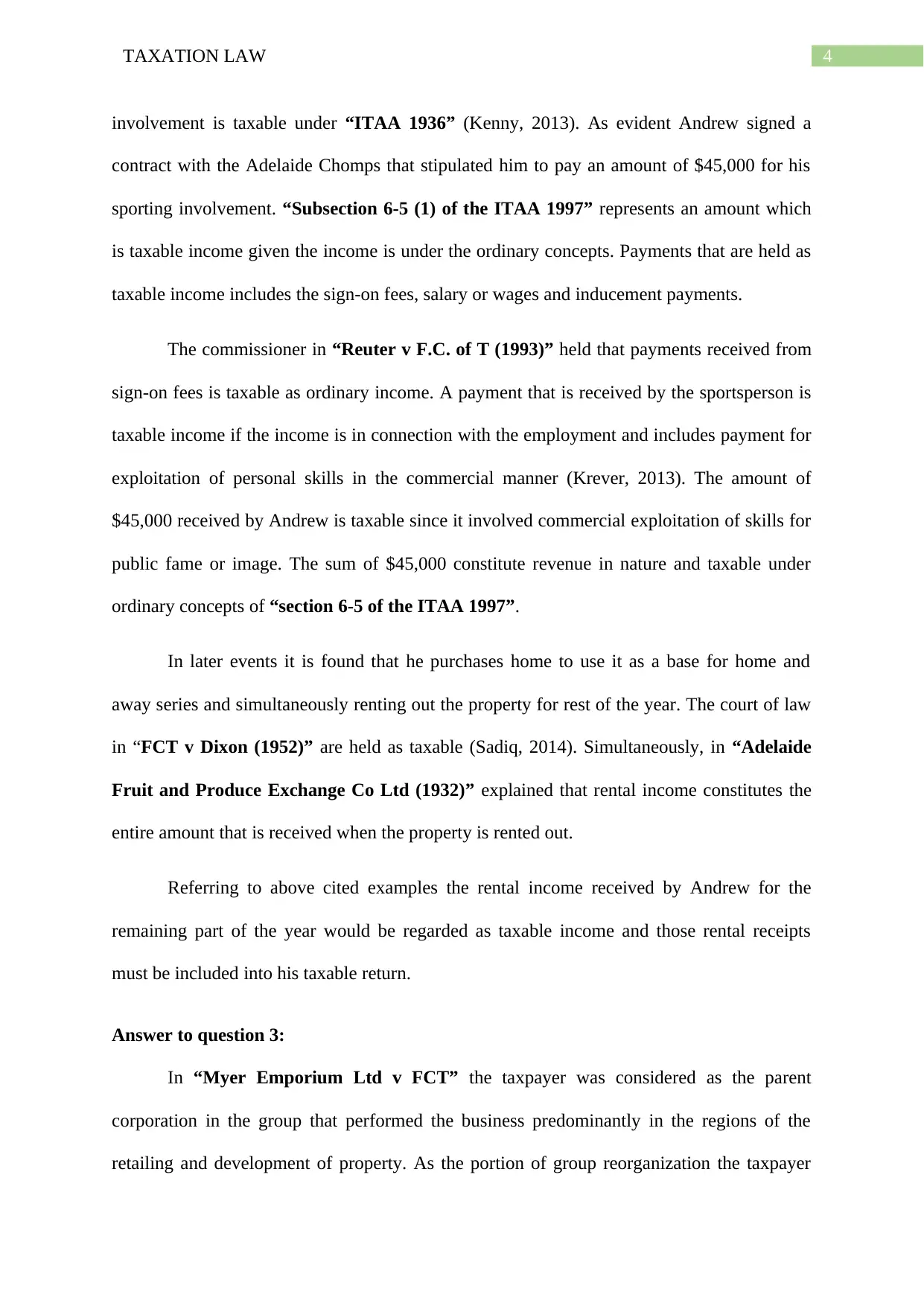
4TAXATION LAW
involvement is taxable under “ITAA 1936” (Kenny, 2013). As evident Andrew signed a
contract with the Adelaide Chomps that stipulated him to pay an amount of $45,000 for his
sporting involvement. “Subsection 6-5 (1) of the ITAA 1997” represents an amount which
is taxable income given the income is under the ordinary concepts. Payments that are held as
taxable income includes the sign-on fees, salary or wages and inducement payments.
The commissioner in “Reuter v F.C. of T (1993)” held that payments received from
sign-on fees is taxable as ordinary income. A payment that is received by the sportsperson is
taxable income if the income is in connection with the employment and includes payment for
exploitation of personal skills in the commercial manner (Krever, 2013). The amount of
$45,000 received by Andrew is taxable since it involved commercial exploitation of skills for
public fame or image. The sum of $45,000 constitute revenue in nature and taxable under
ordinary concepts of “section 6-5 of the ITAA 1997”.
In later events it is found that he purchases home to use it as a base for home and
away series and simultaneously renting out the property for rest of the year. The court of law
in “FCT v Dixon (1952)” are held as taxable (Sadiq, 2014). Simultaneously, in “Adelaide
Fruit and Produce Exchange Co Ltd (1932)” explained that rental income constitutes the
entire amount that is received when the property is rented out.
Referring to above cited examples the rental income received by Andrew for the
remaining part of the year would be regarded as taxable income and those rental receipts
must be included into his taxable return.
Answer to question 3:
In “Myer Emporium Ltd v FCT” the taxpayer was considered as the parent
corporation in the group that performed the business predominantly in the regions of the
retailing and development of property. As the portion of group reorganization the taxpayer
involvement is taxable under “ITAA 1936” (Kenny, 2013). As evident Andrew signed a
contract with the Adelaide Chomps that stipulated him to pay an amount of $45,000 for his
sporting involvement. “Subsection 6-5 (1) of the ITAA 1997” represents an amount which
is taxable income given the income is under the ordinary concepts. Payments that are held as
taxable income includes the sign-on fees, salary or wages and inducement payments.
The commissioner in “Reuter v F.C. of T (1993)” held that payments received from
sign-on fees is taxable as ordinary income. A payment that is received by the sportsperson is
taxable income if the income is in connection with the employment and includes payment for
exploitation of personal skills in the commercial manner (Krever, 2013). The amount of
$45,000 received by Andrew is taxable since it involved commercial exploitation of skills for
public fame or image. The sum of $45,000 constitute revenue in nature and taxable under
ordinary concepts of “section 6-5 of the ITAA 1997”.
In later events it is found that he purchases home to use it as a base for home and
away series and simultaneously renting out the property for rest of the year. The court of law
in “FCT v Dixon (1952)” are held as taxable (Sadiq, 2014). Simultaneously, in “Adelaide
Fruit and Produce Exchange Co Ltd (1932)” explained that rental income constitutes the
entire amount that is received when the property is rented out.
Referring to above cited examples the rental income received by Andrew for the
remaining part of the year would be regarded as taxable income and those rental receipts
must be included into his taxable return.
Answer to question 3:
In “Myer Emporium Ltd v FCT” the taxpayer was considered as the parent
corporation in the group that performed the business predominantly in the regions of the
retailing and development of property. As the portion of group reorganization the taxpayer
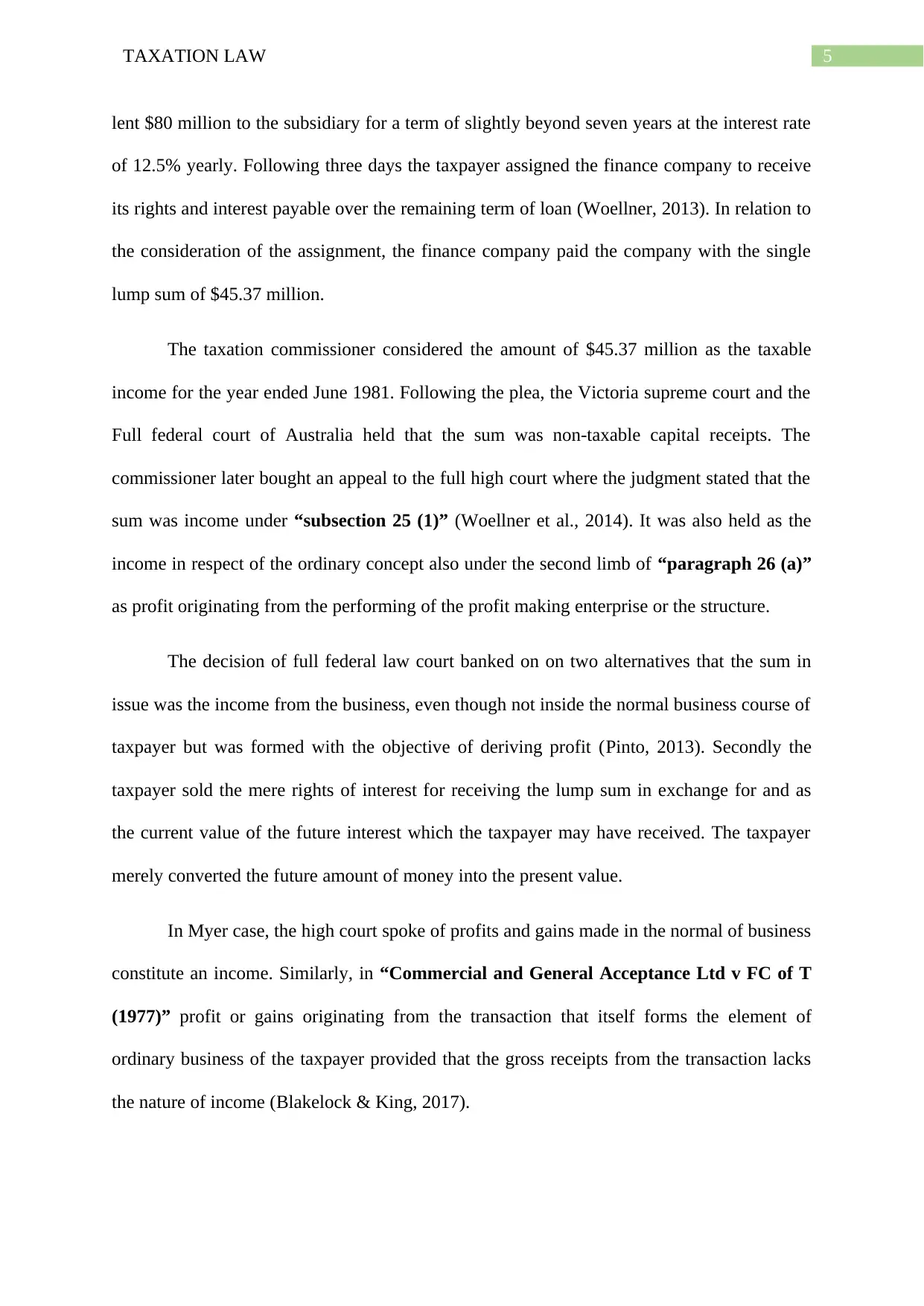
5TAXATION LAW
lent $80 million to the subsidiary for a term of slightly beyond seven years at the interest rate
of 12.5% yearly. Following three days the taxpayer assigned the finance company to receive
its rights and interest payable over the remaining term of loan (Woellner, 2013). In relation to
the consideration of the assignment, the finance company paid the company with the single
lump sum of $45.37 million.
The taxation commissioner considered the amount of $45.37 million as the taxable
income for the year ended June 1981. Following the plea, the Victoria supreme court and the
Full federal court of Australia held that the sum was non-taxable capital receipts. The
commissioner later bought an appeal to the full high court where the judgment stated that the
sum was income under “subsection 25 (1)” (Woellner et al., 2014). It was also held as the
income in respect of the ordinary concept also under the second limb of “paragraph 26 (a)”
as profit originating from the performing of the profit making enterprise or the structure.
The decision of full federal law court banked on on two alternatives that the sum in
issue was the income from the business, even though not inside the normal business course of
taxpayer but was formed with the objective of deriving profit (Pinto, 2013). Secondly the
taxpayer sold the mere rights of interest for receiving the lump sum in exchange for and as
the current value of the future interest which the taxpayer may have received. The taxpayer
merely converted the future amount of money into the present value.
In Myer case, the high court spoke of profits and gains made in the normal of business
constitute an income. Similarly, in “Commercial and General Acceptance Ltd v FC of T
(1977)” profit or gains originating from the transaction that itself forms the element of
ordinary business of the taxpayer provided that the gross receipts from the transaction lacks
the nature of income (Blakelock & King, 2017).
lent $80 million to the subsidiary for a term of slightly beyond seven years at the interest rate
of 12.5% yearly. Following three days the taxpayer assigned the finance company to receive
its rights and interest payable over the remaining term of loan (Woellner, 2013). In relation to
the consideration of the assignment, the finance company paid the company with the single
lump sum of $45.37 million.
The taxation commissioner considered the amount of $45.37 million as the taxable
income for the year ended June 1981. Following the plea, the Victoria supreme court and the
Full federal court of Australia held that the sum was non-taxable capital receipts. The
commissioner later bought an appeal to the full high court where the judgment stated that the
sum was income under “subsection 25 (1)” (Woellner et al., 2014). It was also held as the
income in respect of the ordinary concept also under the second limb of “paragraph 26 (a)”
as profit originating from the performing of the profit making enterprise or the structure.
The decision of full federal law court banked on on two alternatives that the sum in
issue was the income from the business, even though not inside the normal business course of
taxpayer but was formed with the objective of deriving profit (Pinto, 2013). Secondly the
taxpayer sold the mere rights of interest for receiving the lump sum in exchange for and as
the current value of the future interest which the taxpayer may have received. The taxpayer
merely converted the future amount of money into the present value.
In Myer case, the high court spoke of profits and gains made in the normal of business
constitute an income. Similarly, in “Commercial and General Acceptance Ltd v FC of T
(1977)” profit or gains originating from the transaction that itself forms the element of
ordinary business of the taxpayer provided that the gross receipts from the transaction lacks
the nature of income (Blakelock & King, 2017).
⊘ This is a preview!⊘
Do you want full access?
Subscribe today to unlock all pages.

Trusted by 1+ million students worldwide
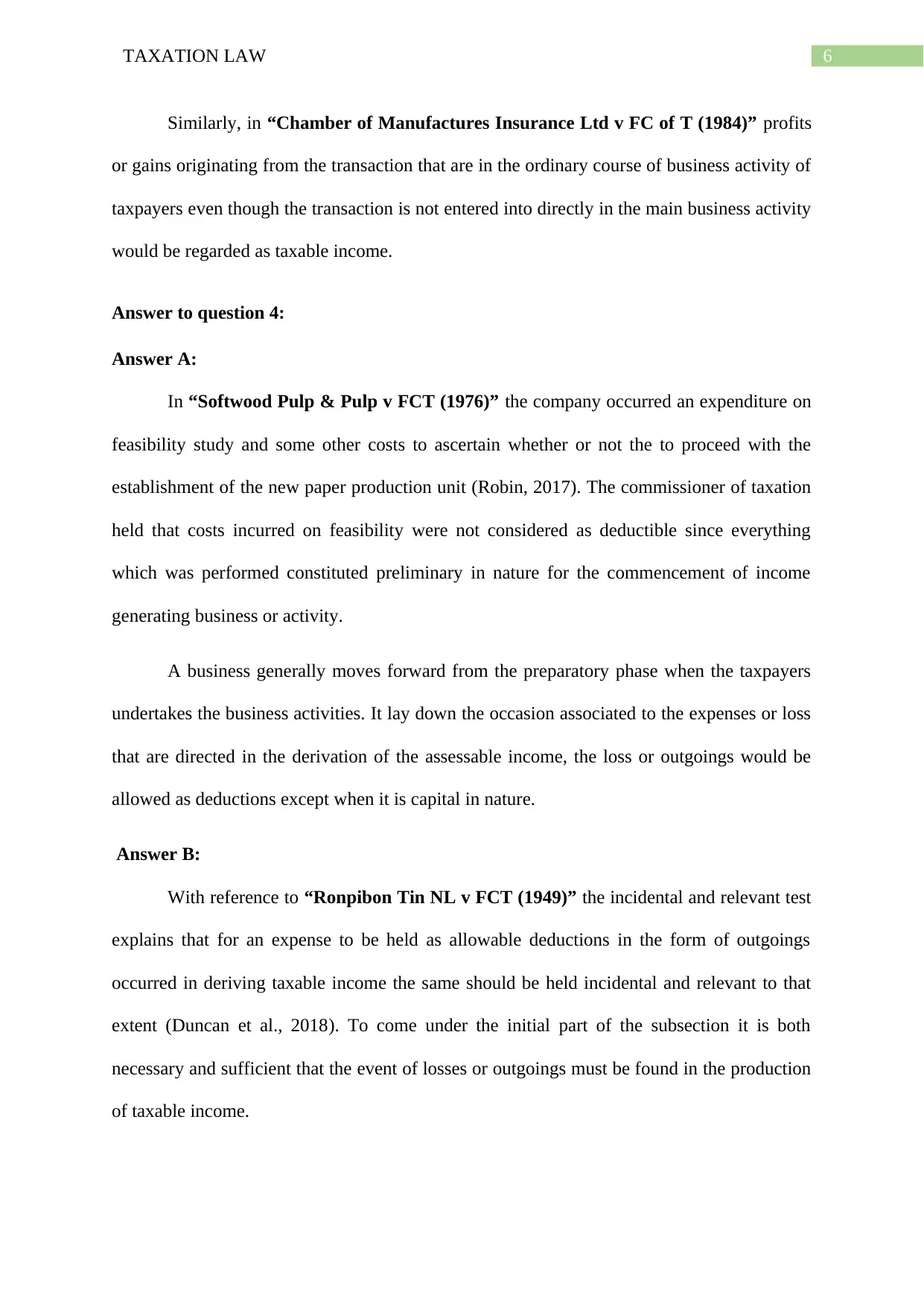
6TAXATION LAW
Similarly, in “Chamber of Manufactures Insurance Ltd v FC of T (1984)” profits
or gains originating from the transaction that are in the ordinary course of business activity of
taxpayers even though the transaction is not entered into directly in the main business activity
would be regarded as taxable income.
Answer to question 4:
Answer A:
In “Softwood Pulp & Pulp v FCT (1976)” the company occurred an expenditure on
feasibility study and some other costs to ascertain whether or not the to proceed with the
establishment of the new paper production unit (Robin, 2017). The commissioner of taxation
held that costs incurred on feasibility were not considered as deductible since everything
which was performed constituted preliminary in nature for the commencement of income
generating business or activity.
A business generally moves forward from the preparatory phase when the taxpayers
undertakes the business activities. It lay down the occasion associated to the expenses or loss
that are directed in the derivation of the assessable income, the loss or outgoings would be
allowed as deductions except when it is capital in nature.
Answer B:
With reference to “Ronpibon Tin NL v FCT (1949)” the incidental and relevant test
explains that for an expense to be held as allowable deductions in the form of outgoings
occurred in deriving taxable income the same should be held incidental and relevant to that
extent (Duncan et al., 2018). To come under the initial part of the subsection it is both
necessary and sufficient that the event of losses or outgoings must be found in the production
of taxable income.
Similarly, in “Chamber of Manufactures Insurance Ltd v FC of T (1984)” profits
or gains originating from the transaction that are in the ordinary course of business activity of
taxpayers even though the transaction is not entered into directly in the main business activity
would be regarded as taxable income.
Answer to question 4:
Answer A:
In “Softwood Pulp & Pulp v FCT (1976)” the company occurred an expenditure on
feasibility study and some other costs to ascertain whether or not the to proceed with the
establishment of the new paper production unit (Robin, 2017). The commissioner of taxation
held that costs incurred on feasibility were not considered as deductible since everything
which was performed constituted preliminary in nature for the commencement of income
generating business or activity.
A business generally moves forward from the preparatory phase when the taxpayers
undertakes the business activities. It lay down the occasion associated to the expenses or loss
that are directed in the derivation of the assessable income, the loss or outgoings would be
allowed as deductions except when it is capital in nature.
Answer B:
With reference to “Ronpibon Tin NL v FCT (1949)” the incidental and relevant test
explains that for an expense to be held as allowable deductions in the form of outgoings
occurred in deriving taxable income the same should be held incidental and relevant to that
extent (Duncan et al., 2018). To come under the initial part of the subsection it is both
necessary and sufficient that the event of losses or outgoings must be found in the production
of taxable income.
Paraphrase This Document
Need a fresh take? Get an instant paraphrase of this document with our AI Paraphraser
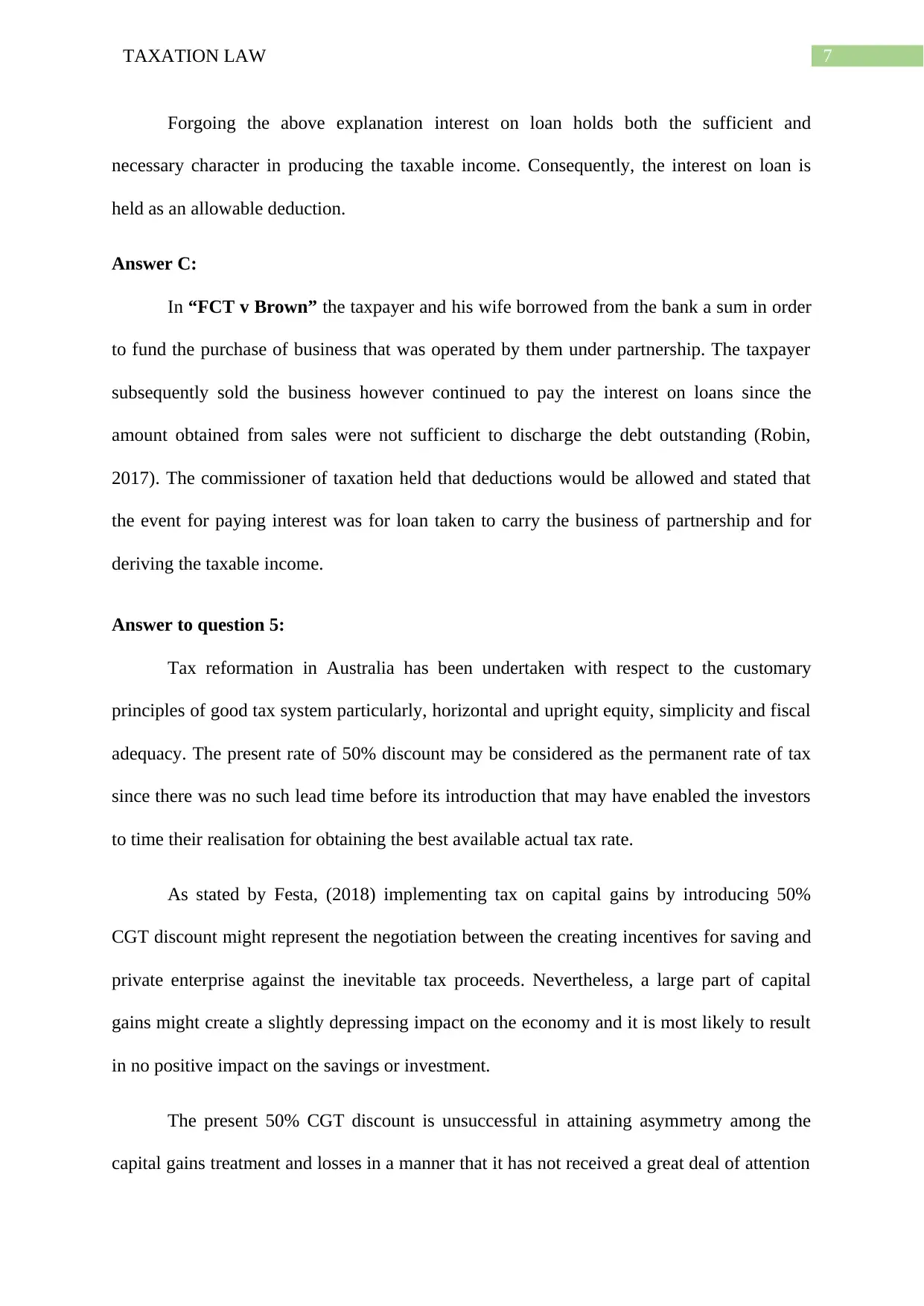
7TAXATION LAW
Forgoing the above explanation interest on loan holds both the sufficient and
necessary character in producing the taxable income. Consequently, the interest on loan is
held as an allowable deduction.
Answer C:
In “FCT v Brown” the taxpayer and his wife borrowed from the bank a sum in order
to fund the purchase of business that was operated by them under partnership. The taxpayer
subsequently sold the business however continued to pay the interest on loans since the
amount obtained from sales were not sufficient to discharge the debt outstanding (Robin,
2017). The commissioner of taxation held that deductions would be allowed and stated that
the event for paying interest was for loan taken to carry the business of partnership and for
deriving the taxable income.
Answer to question 5:
Tax reformation in Australia has been undertaken with respect to the customary
principles of good tax system particularly, horizontal and upright equity, simplicity and fiscal
adequacy. The present rate of 50% discount may be considered as the permanent rate of tax
since there was no such lead time before its introduction that may have enabled the investors
to time their realisation for obtaining the best available actual tax rate.
As stated by Festa, (2018) implementing tax on capital gains by introducing 50%
CGT discount might represent the negotiation between the creating incentives for saving and
private enterprise against the inevitable tax proceeds. Nevertheless, a large part of capital
gains might create a slightly depressing impact on the economy and it is most likely to result
in no positive impact on the savings or investment.
The present 50% CGT discount is unsuccessful in attaining asymmetry among the
capital gains treatment and losses in a manner that it has not received a great deal of attention
Forgoing the above explanation interest on loan holds both the sufficient and
necessary character in producing the taxable income. Consequently, the interest on loan is
held as an allowable deduction.
Answer C:
In “FCT v Brown” the taxpayer and his wife borrowed from the bank a sum in order
to fund the purchase of business that was operated by them under partnership. The taxpayer
subsequently sold the business however continued to pay the interest on loans since the
amount obtained from sales were not sufficient to discharge the debt outstanding (Robin,
2017). The commissioner of taxation held that deductions would be allowed and stated that
the event for paying interest was for loan taken to carry the business of partnership and for
deriving the taxable income.
Answer to question 5:
Tax reformation in Australia has been undertaken with respect to the customary
principles of good tax system particularly, horizontal and upright equity, simplicity and fiscal
adequacy. The present rate of 50% discount may be considered as the permanent rate of tax
since there was no such lead time before its introduction that may have enabled the investors
to time their realisation for obtaining the best available actual tax rate.
As stated by Festa, (2018) implementing tax on capital gains by introducing 50%
CGT discount might represent the negotiation between the creating incentives for saving and
private enterprise against the inevitable tax proceeds. Nevertheless, a large part of capital
gains might create a slightly depressing impact on the economy and it is most likely to result
in no positive impact on the savings or investment.
The present 50% CGT discount is unsuccessful in attaining asymmetry among the
capital gains treatment and losses in a manner that it has not received a great deal of attention
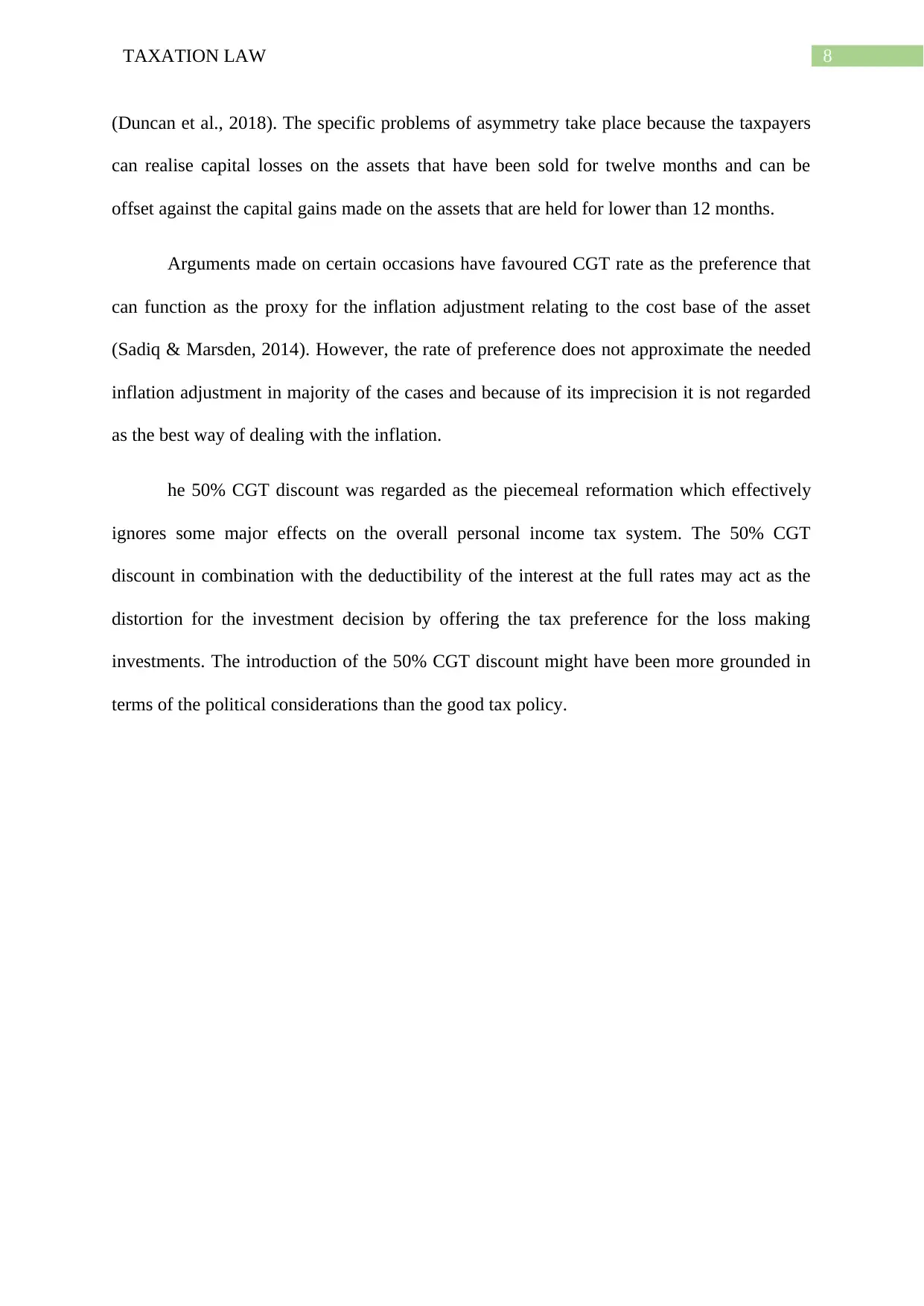
8TAXATION LAW
(Duncan et al., 2018). The specific problems of asymmetry take place because the taxpayers
can realise capital losses on the assets that have been sold for twelve months and can be
offset against the capital gains made on the assets that are held for lower than 12 months.
Arguments made on certain occasions have favoured CGT rate as the preference that
can function as the proxy for the inflation adjustment relating to the cost base of the asset
(Sadiq & Marsden, 2014). However, the rate of preference does not approximate the needed
inflation adjustment in majority of the cases and because of its imprecision it is not regarded
as the best way of dealing with the inflation.
he 50% CGT discount was regarded as the piecemeal reformation which effectively
ignores some major effects on the overall personal income tax system. The 50% CGT
discount in combination with the deductibility of the interest at the full rates may act as the
distortion for the investment decision by offering the tax preference for the loss making
investments. The introduction of the 50% CGT discount might have been more grounded in
terms of the political considerations than the good tax policy.
(Duncan et al., 2018). The specific problems of asymmetry take place because the taxpayers
can realise capital losses on the assets that have been sold for twelve months and can be
offset against the capital gains made on the assets that are held for lower than 12 months.
Arguments made on certain occasions have favoured CGT rate as the preference that
can function as the proxy for the inflation adjustment relating to the cost base of the asset
(Sadiq & Marsden, 2014). However, the rate of preference does not approximate the needed
inflation adjustment in majority of the cases and because of its imprecision it is not regarded
as the best way of dealing with the inflation.
he 50% CGT discount was regarded as the piecemeal reformation which effectively
ignores some major effects on the overall personal income tax system. The 50% CGT
discount in combination with the deductibility of the interest at the full rates may act as the
distortion for the investment decision by offering the tax preference for the loss making
investments. The introduction of the 50% CGT discount might have been more grounded in
terms of the political considerations than the good tax policy.
⊘ This is a preview!⊘
Do you want full access?
Subscribe today to unlock all pages.

Trusted by 1+ million students worldwide
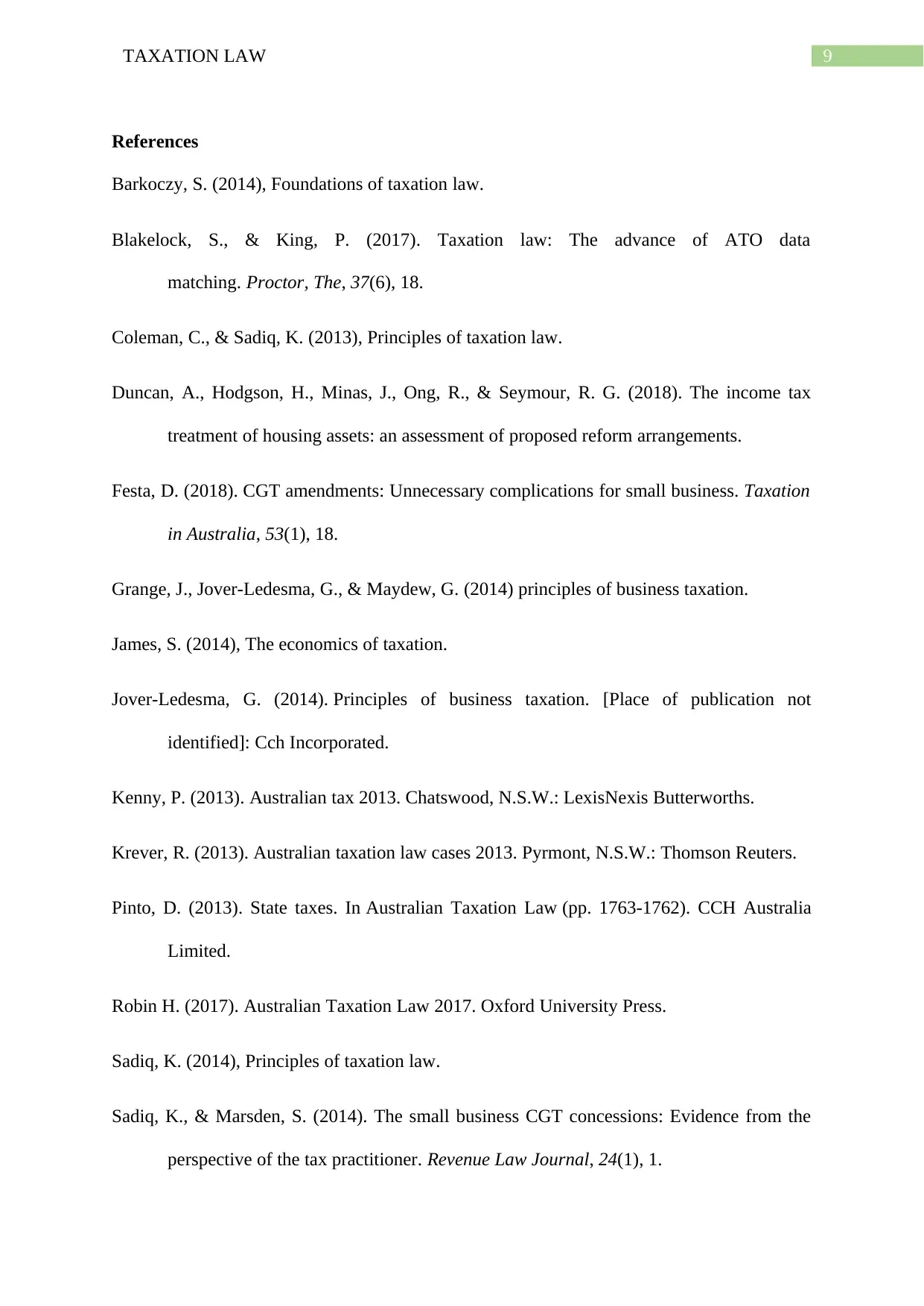
9TAXATION LAW
References
Barkoczy, S. (2014), Foundations of taxation law.
Blakelock, S., & King, P. (2017). Taxation law: The advance of ATO data
matching. Proctor, The, 37(6), 18.
Coleman, C., & Sadiq, K. (2013), Principles of taxation law.
Duncan, A., Hodgson, H., Minas, J., Ong, R., & Seymour, R. G. (2018). The income tax
treatment of housing assets: an assessment of proposed reform arrangements.
Festa, D. (2018). CGT amendments: Unnecessary complications for small business. Taxation
in Australia, 53(1), 18.
Grange, J., Jover-Ledesma, G., & Maydew, G. (2014) principles of business taxation.
James, S. (2014), The economics of taxation.
Jover-Ledesma, G. (2014). Principles of business taxation. [Place of publication not
identified]: Cch Incorporated.
Kenny, P. (2013). Australian tax 2013. Chatswood, N.S.W.: LexisNexis Butterworths.
Krever, R. (2013). Australian taxation law cases 2013. Pyrmont, N.S.W.: Thomson Reuters.
Pinto, D. (2013). State taxes. In Australian Taxation Law (pp. 1763-1762). CCH Australia
Limited.
Robin H. (2017). Australian Taxation Law 2017. Oxford University Press.
Sadiq, K. (2014), Principles of taxation law.
Sadiq, K., & Marsden, S. (2014). The small business CGT concessions: Evidence from the
perspective of the tax practitioner. Revenue Law Journal, 24(1), 1.
References
Barkoczy, S. (2014), Foundations of taxation law.
Blakelock, S., & King, P. (2017). Taxation law: The advance of ATO data
matching. Proctor, The, 37(6), 18.
Coleman, C., & Sadiq, K. (2013), Principles of taxation law.
Duncan, A., Hodgson, H., Minas, J., Ong, R., & Seymour, R. G. (2018). The income tax
treatment of housing assets: an assessment of proposed reform arrangements.
Festa, D. (2018). CGT amendments: Unnecessary complications for small business. Taxation
in Australia, 53(1), 18.
Grange, J., Jover-Ledesma, G., & Maydew, G. (2014) principles of business taxation.
James, S. (2014), The economics of taxation.
Jover-Ledesma, G. (2014). Principles of business taxation. [Place of publication not
identified]: Cch Incorporated.
Kenny, P. (2013). Australian tax 2013. Chatswood, N.S.W.: LexisNexis Butterworths.
Krever, R. (2013). Australian taxation law cases 2013. Pyrmont, N.S.W.: Thomson Reuters.
Pinto, D. (2013). State taxes. In Australian Taxation Law (pp. 1763-1762). CCH Australia
Limited.
Robin H. (2017). Australian Taxation Law 2017. Oxford University Press.
Sadiq, K. (2014), Principles of taxation law.
Sadiq, K., & Marsden, S. (2014). The small business CGT concessions: Evidence from the
perspective of the tax practitioner. Revenue Law Journal, 24(1), 1.
Paraphrase This Document
Need a fresh take? Get an instant paraphrase of this document with our AI Paraphraser
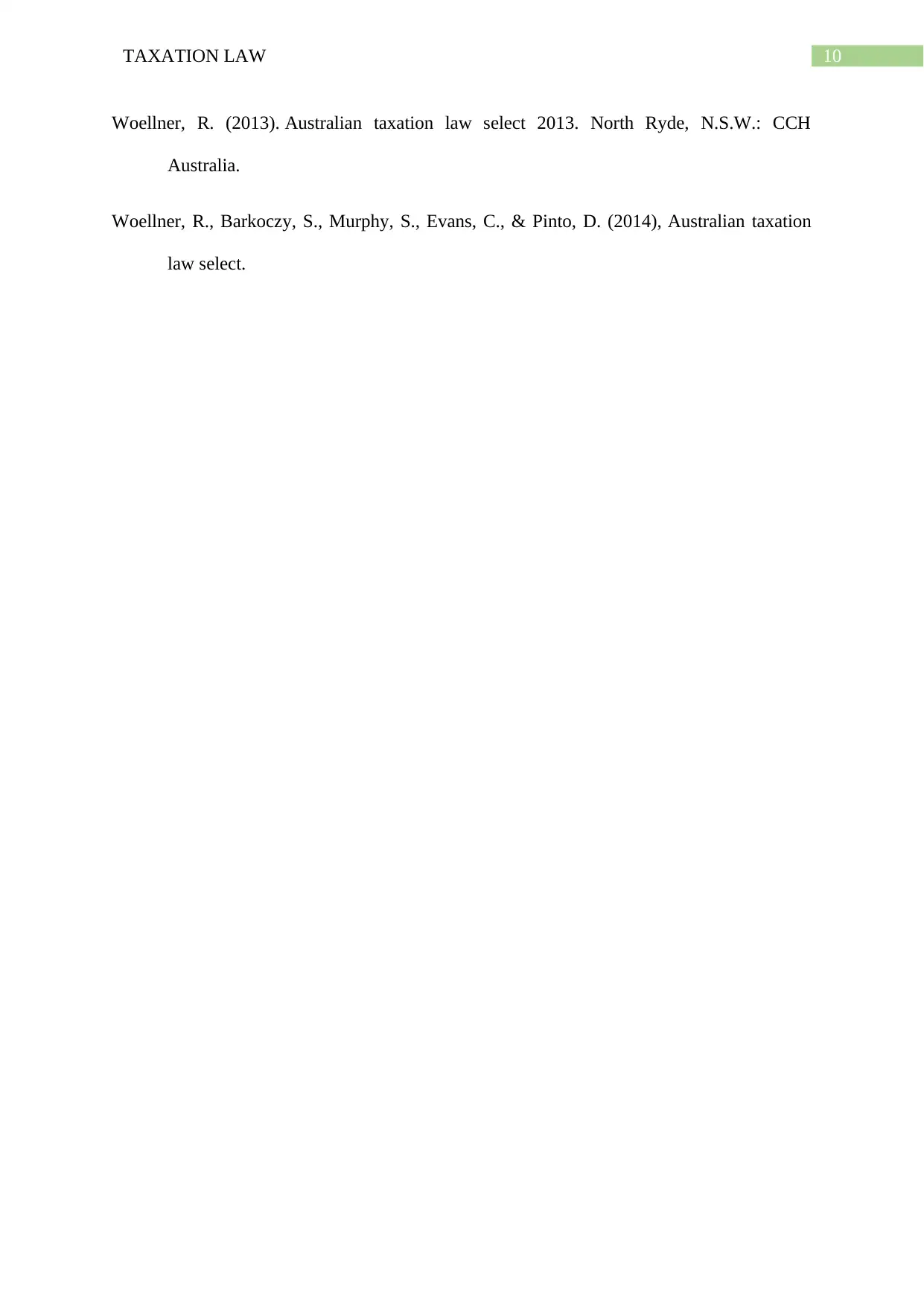
10TAXATION LAW
Woellner, R. (2013). Australian taxation law select 2013. North Ryde, N.S.W.: CCH
Australia.
Woellner, R., Barkoczy, S., Murphy, S., Evans, C., & Pinto, D. (2014), Australian taxation
law select.
Woellner, R. (2013). Australian taxation law select 2013. North Ryde, N.S.W.: CCH
Australia.
Woellner, R., Barkoczy, S., Murphy, S., Evans, C., & Pinto, D. (2014), Australian taxation
law select.
1 out of 11
Related Documents
Your All-in-One AI-Powered Toolkit for Academic Success.
+13062052269
info@desklib.com
Available 24*7 on WhatsApp / Email
![[object Object]](/_next/static/media/star-bottom.7253800d.svg)
Unlock your academic potential
Copyright © 2020–2025 A2Z Services. All Rights Reserved. Developed and managed by ZUCOL.


